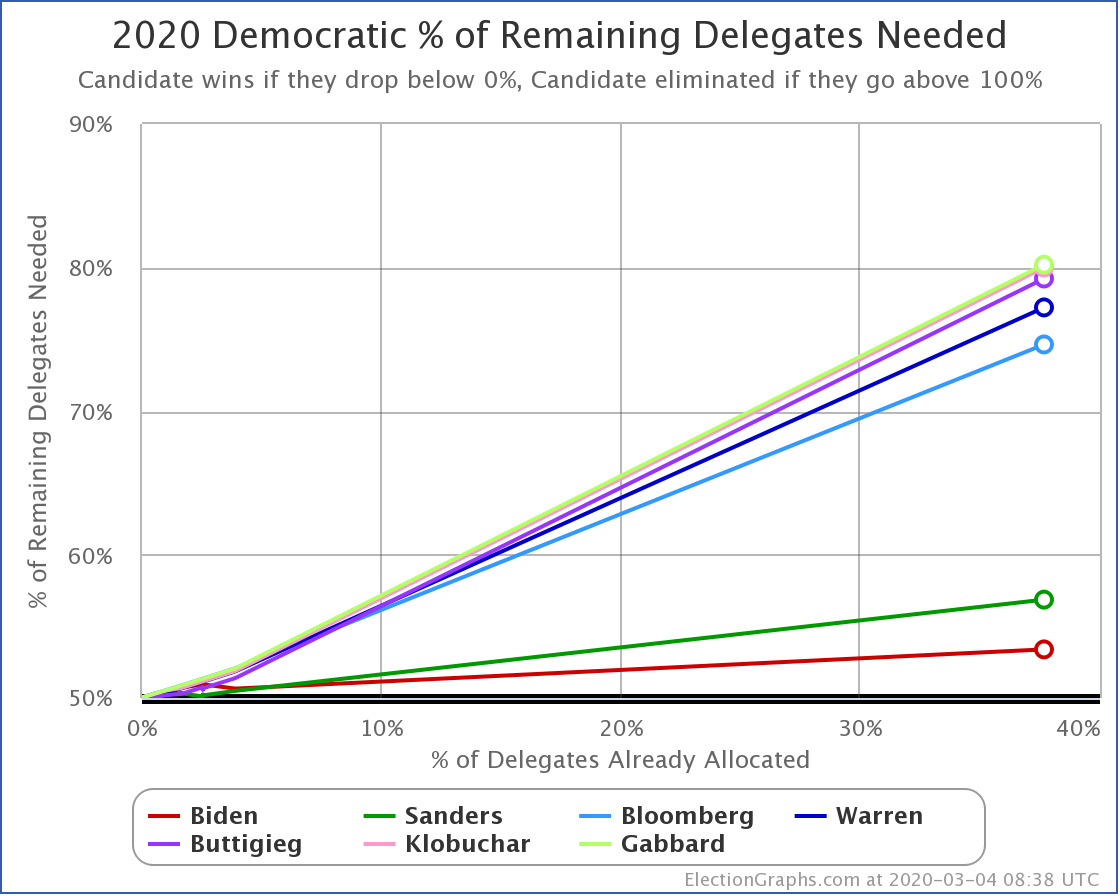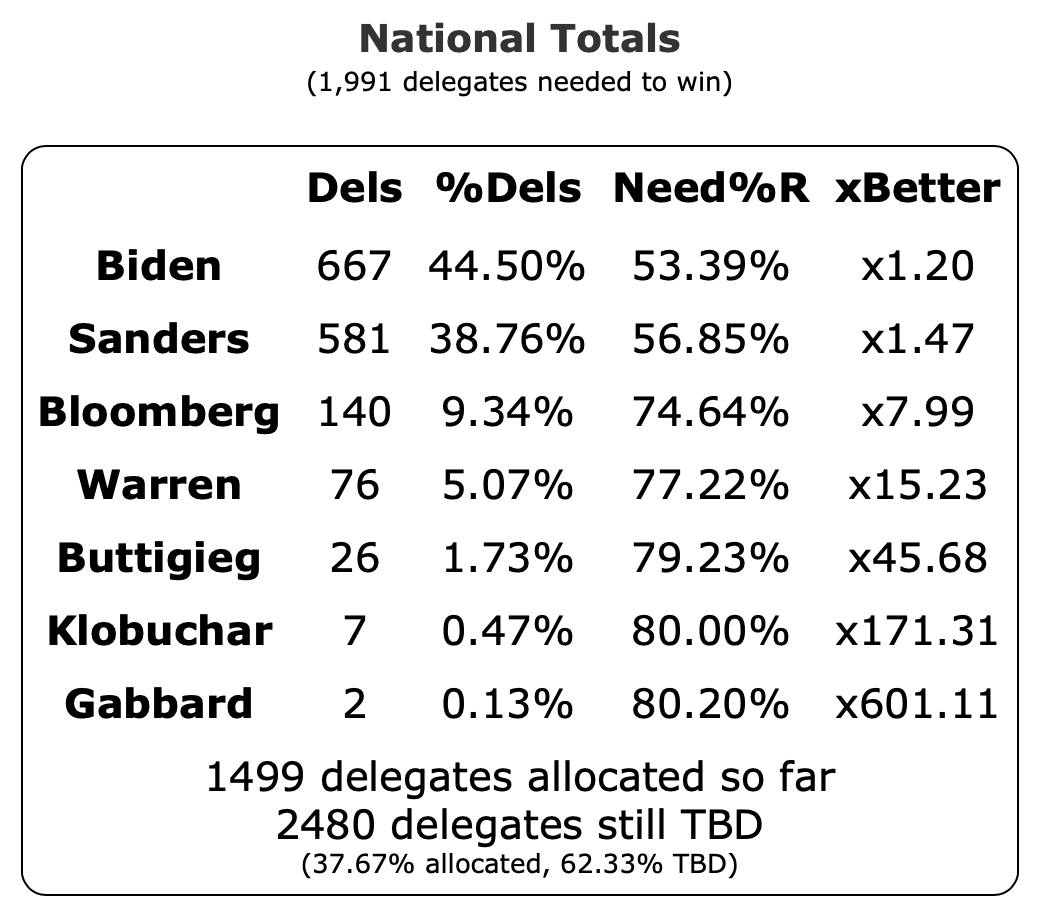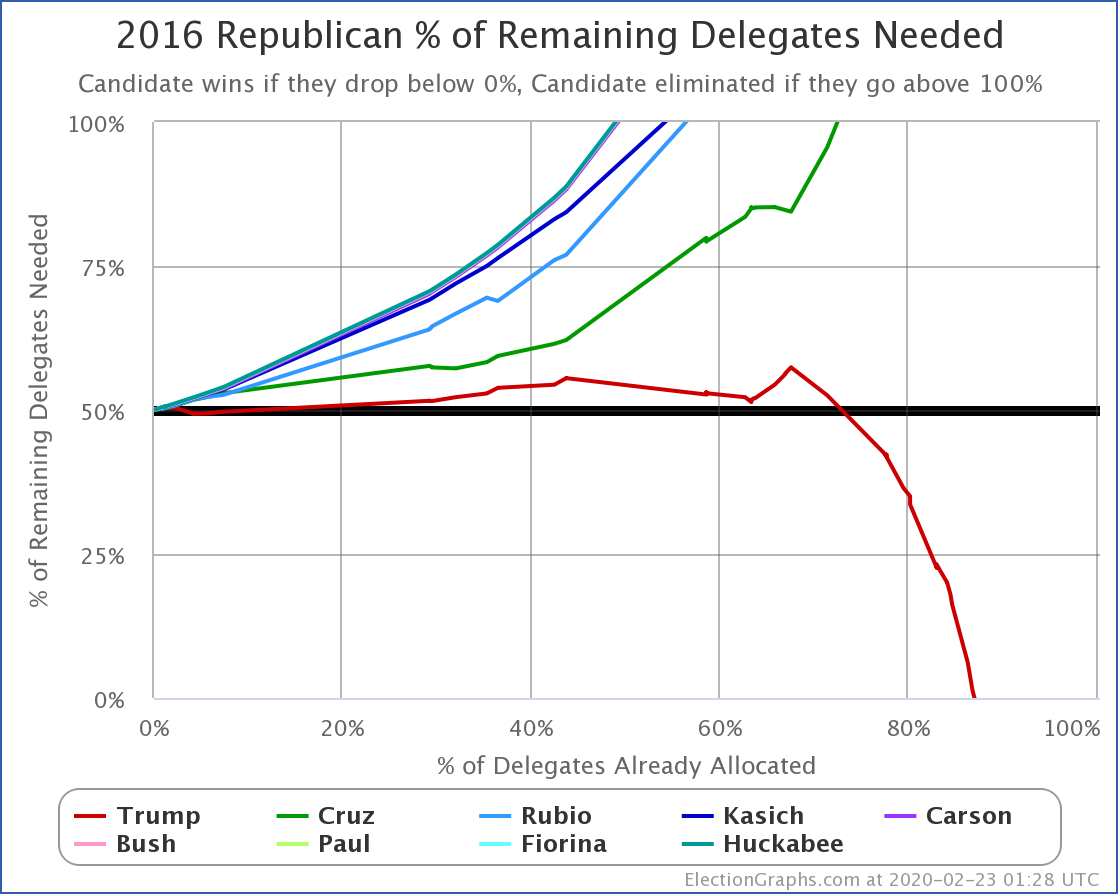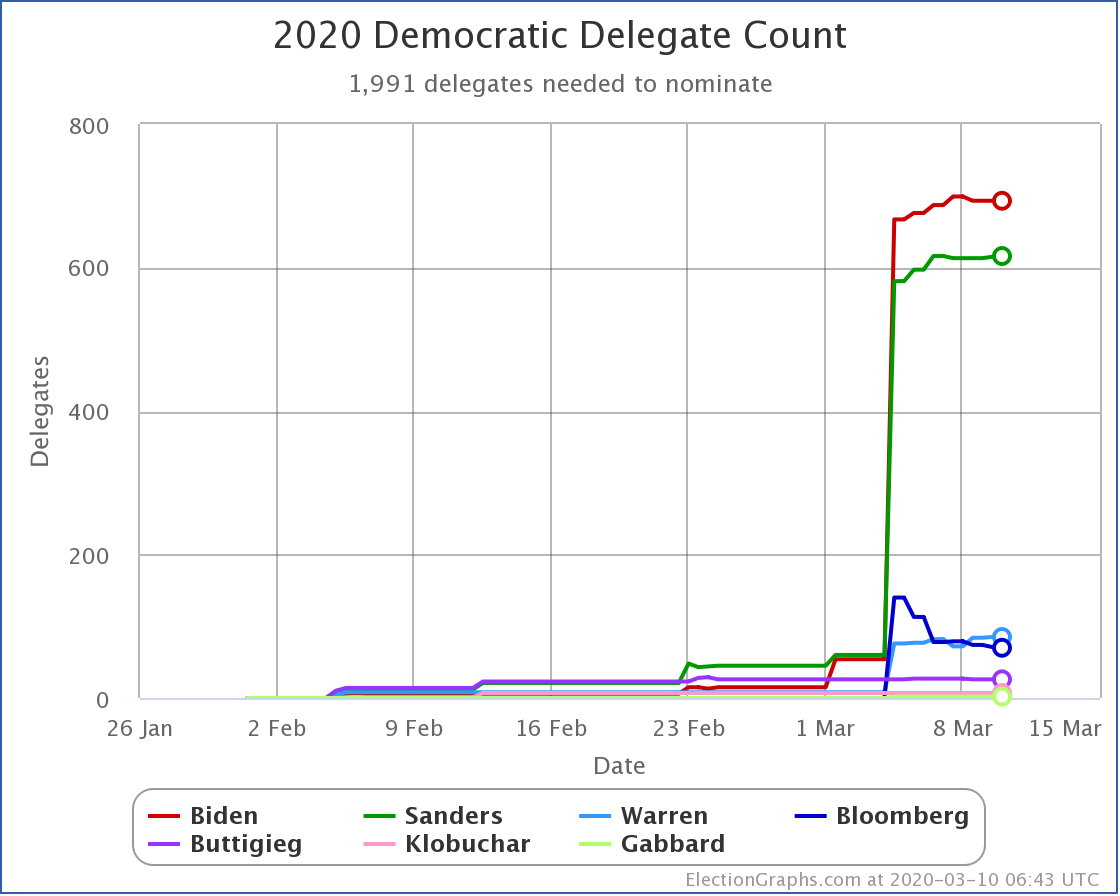The delegate counts will continue to shift for days, perhaps weeks, as counts are finalized, especially in California, which is notorious for how slow it is at counting the vote, but as of the morning after Super Tuesday, we have a good idea of how Super Tuesday went.
There were 1357 delegates on my list for Super Tuesday. We have results for all of that except the 13 for Democrats Abroad, for which I guess we will have to wait a little while longer. Of the 1344 other delegates, the distribution as of right now is:
- Biden 613
- Sanders 521
- Bloomberg 140
- Warren 68
- Gabbard 2
If there are minor changes to these totals as vote counting continues, I'll add updates to the bottom of this post on a daily basis. If there are changes that are big enough to change the overall picture, I'll make a new post.
In the meantime, forget what states the various delegates come from. That doesn't really matter. Only the delegate totals matter.
Obviously the big news is Biden.
Even though Biden was surging out of South Carolina, the expectation was still that Sanders would get the most delegates out of Super Tuesday, and quite probably amass a significant lead over Biden in the total delegate count.
Nope. It didn't happen.
Instead, Biden had a huge night.
Looking back at my post-South Carolina post, I had done some math and pointed at a milestone to watch for in terms of the Sanders delegate haul. That number was 686 Super Tuesday delegates. Correcting for not having Democrats Abroad, that shifts to 679 delegates.
I had laid out possibilities for where things looked to be headed if the Sanders total was way above, near, or way below that number.
Sanders fell significantly below that number.
Which pointed toward this possibility being in play:
"All lines heading upward: By gosh, a contested convention may be a real possibility!"
So are all lines heading upward?


So that would be a yes. While Sanders came nowhere near the 676 delegates he needed to be on track for 1991 delegates, Biden would have needed 681, and although Biden came closer, he didn't hit that milestone either.
No candidate has been on pace yet to get to 1991.
But does that mean we will have no candidate with a majority by the end of the primary season?
No. Not at all.
Time to look back at my post-Nevada update where I looked at the 2008 to 2016 races as a comparison.
We're only at the 37.67% mark in this race.
Looking at when the winner's lines started making the big turn down toward a clear victory in previous years:
- 0% for the Democrats in 2016
- 5% for the Republicans in 2008
- 43% for the Republicans in 2012
- 50% for the Democrats in 2008
- 67% for the Republicans in 2016
Sure, we are past the turning point for the Dems in 2016 and Republicans in 2008, but those were the two races where things were clear the soonest.
But when the turn happened is not the only thing to look at here. The other is what the maximum "% of remaining needed to win" each winning candidate hit.
Right now Biden needs 53.39% of the remaining delegates to win. How does this compare to the worst situation each winning candidate was in before actually managing to win?
- 50.02% – Clinton's worst spot in 2016
- 50.29% – Romney's worst spot in 2012
- 51.84% – McCain's worst spot in 2008
- 53.02% – Obama's worst spot in 2008
- 57.41% – Trump's worst spot in 2016
At the closest equivalent time in the cycle to where we are now (when the 2016 Republicans had allocated 36.45% of their delegates), Trump needed 53.85% of the remaining delegates to win.
That was worse off than Biden is today. But he ended up with a majority of the delegates. We did not have a battle at the 2016 Republican convention.
What happened? Let's look at the chart for the 2016 Republicans again:

At this point in 2016, Trump was at 53.85%. His closest competition was Cruz, who was at 59.39%.
Cruz stayed in the race for quite a bit past this point. He kept competing. He kept collecting delegates.
Those Cruz delegates, as well as the delegates from some of the others, managed to keep Trump from consistently hitting the delegate pace he needed. But sometimes he did, so he basically managed to keep his line flat. The Trump line never was rushing rapidly up toward 100%.
But meanwhile, Cruz (and the others) only hit the needed pace on a couple of isolated occasions. For the most part, every time there were delegates allocated, they fell further and further behind Trump.
Eventually, once it became clear that there was no way to win, one by one all the other Republicans dropped out. The last hold outs were Cruz and Kasich.
But it just wasn't feasible for them to continue on with no chance of a majority, only an increasingly desperate "stop Trump" narrative in the face of Trump winning victory after victory.
Now, a quick look at 2020 on the same scale:

The one thing that is immediately obvious is that Sanders is closer to Biden than Cruz was to Trump.
In 2016 Trump was at 53.85% while Cruz was at 59.39% for a 5.54% gap.
Right now Biden is at 53.39% while Sanders is at 56.85% for a 3.46% gap.
This means that the path for Sanders to actually hit marks to catch up isn't quite as bad as it was for Cruz in 2016.
But 56.85% is still a pretty high mark to need to hit.
To get to a contested convention scenario, you need BOTH Biden and Sanders to miss their delegate targets more often than they hit them.
And it would certainly help if someone else continues to accumulate at least a few delegates as well, even though they clearly can't win.
But as of the writing of this post, Buttigieg and Klobuchar were already out, news has just broken that Bloomberg is dropping out, and Warren is considering her options. Absent a massive surge for Warren or Gabbard, it looks like we now have a true two-person race. Which makes it harder to get to a contested convention.
Although it is still possible that we get there, now that we only have two serious candidates, the scenario where the leader (currently Biden) just builds on their momentum and starts getting what they need for a majority seems more and more likely.
The next primary date is March 10th when Michigan (125 delegates), Washington (89 delegates), Missouri (68 delegates), Mississippi (36 delegates), Idaho (20 delegates), and North Dakota (14 delegates) have their say. That adds up to 352 delegates.
To be on track for 1991:
- Biden needs at least 188 of the 352 delegates
- Sanders needs at least 201 of the 352 delegates
These are difficult numbers, but not impossible numbers. Especially now that we only have two serious candidates left.
If one of them hits their number, we may well be on the path for an actual direct winner.
If both of them fail to hit those marks, then the chances of a contested convention stay alive a little while longer.
Basically, assuming no additional delegate accumulation by anybody else, the gap between the top two has to remain less than the total number of delegates held by the also-rans. If they both keep winning states, and those victories are pretty narrow, then that is still possible.
But honestly, it seems like as usual, the chances of a contested convention are slipping away… and it looks like things are coming up Biden.
131.1 days until the Democratic National Convention.
173.1 days until the Republican National Convention.
Update 2020-03-05 01:01 UTC: The votes continue to be counted, and so the delegate estimates change. I'll be updating here no more than once a day. Since the post above was written, Bloomberg has lost 27 delegates. 16 of those went to Sanders, 9 to Biden, 1 to Warren, and one to Buttigieg. This makes the totals for Super Tuesday: Biden 622, Sanders 537, Bloomberg 113, Warren 69, Gabbard 2, Buttigieg 1. And the overall totals: Biden 676, Sanders 597, Bloomberg 113, Warren 77, Buttigieg 27, Klobuchar 7, Gabbard 2. This makes Biden's new magic number 53.02% (187 delegates on March 10th), and Sanders's number 56.21% (198 delegates on March 10th).
Update 2020-03-06 01:18 UTC: Bloomberg continues to bleed delegates as vote counting continues. Since yesterday's update, Bloomberg lost 35 more delegates. 19 went to Sanders, 11 went to Biden, and 5 went to Warren. New Super Tuesday totals: Biden 633, Sanders 556, Bloomberg 78, Warren 74, Gabbard 2, Buttigieg 1. And the overall totals: Biden 687, Sanders 616, Warren 82, Bloomberg 78, Buttigieg 27, Klobuchar 7, Gabbard 2. So Biden's new magic number is 52.58% (186 delegates on March 10th). Sanders's number is now 55.44% (196 delegates on March 10th).
Update 2020-03-07 01:24 UTC: In today's update Warren loses 10 delegates and Sanders loses 3. They go 12 to Biden, 1 to Bloomberg. New Super Tuesday totals: Biden 645, Sanders 553, Bloomberg 79, Warren 64, Gabbard 2, Buttigieg 1. New overall totals: Biden 699, Sanders 613, Bloomberg 79, Warren 72, Buttigieg 27, Klobuchar 7, Gabbard 2. Biden's new magic number is 52.10% (184 delegates on March 10th). Sanders's new magic number is 55.56% (196 delegates on March 10th).
Update 2020-03-08 01:57 UTC: Today Warren gains back 12 delegates, taking 6 from Biden, 5 from Sanders, and 1 from Buttigieg. New Super Tuesday totals: Biden 639, Sanders 553, Warren 76, Bloomberg 74, Gabbard 2. New overall totals: Biden 683, Sanders 613, Warren 84, Bloomberg 74, Buttigieg 26, Klobuchar 7, Gabbard 2. So Biden's new magic number is 52.34% (185 delegates on March 10th). Sanders's magic number remains 55.56% (196 delegates on March 10th).
Update 2020-03-09 01:48 UTC: Today Bloomberg loses 3 delegates. 2 go to Sanders, 1 goes to Warren. New Super Tuesday totals: Biden 639, Sanders 555, Warren 77, Bloomberg 71, Gabbard 2. New overall totals: Biden 693, Sanders 615, Warren 85, Bloomberg 71, Buttigieg 26, Klobuchar 7, Gabbard 2. So Biden's magic number is still 52.34% (185 delegates on March 10th). Sanders's magic number is now 55.48% (196 delegates on March 10th).
Update 2020-03-10 01:35 UTC: Today Bloomberg gives 1 delegate to Sanders. That's it. New Super Tuesday totals: Biden 639, Sanders 556, Warren 77, Bloomberg 70, Gabbard 2. New overall totals: Biden 693, Sanders 616, Warren 85, Bloomberg 70, Buttigieg 26, Klobuchar 7, Gabbard 2. Biden's magic number is still 52.34% (185 delegates on March 10th). Sanders's number is now 55.44% (196 delegates on March 10th).
For more information:
This post is an update based on the data on the Election Graphs 2020 Delegate Race page. Election Graphs tracks estimates of the convention delegate totals for both parties. The charts, graphs, and maps in the post above are all as of the time of this post. Click through on any image for the current interactive versions of that chart, along with additional details.
Follow @ElectionGraphs on Twitter or Election Graphs on Facebook to see announcements of new blog posts. For those interested in more granular updates of delegate updates or general election polling, follow @ElecCollPolls on Twitter. If you find the information in these posts informative or useful, please consider visiting the donation page.





